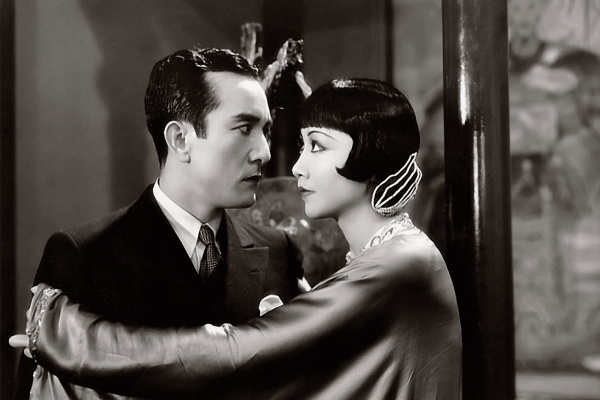IN THE EARLY days of Hollywood, Japanese-born actor Sessue Hayakawa (1886-1973) was an icon. In the context of racist U.S. policy and increasing nativism in Hollywood, he was arguably the first non-Caucasian actor to gain international fame and the first person of Asian descent to become a leading man in the movie industry.
His overall career, however, is a story of race’s shadowy relationship with success. Orientalism, Yellow Peril, and America’s fear of Japan both helped and hurt his career. The Catholic Church’s eventual oversight of Hollywood also played a part in his troubles. The only way Hayakawa thrived in the industry was by playing into the structures of racism that set up his stardom.
“Such roles are not true ...”
IN 1915, WITH actress Fannie Ward, Hayakawa had the first on-screen interracial kiss.
Well before the Motion Picture Production Code outlawed interracial romance in 1930, the silent film The Cheat (1915) shows Edith Hardy (Ward) as a wife who takes money from the Red Cross, loses the $10,000, and then struggles to repay her debt. As she reels from the news of her loss in a semiconscious state, an acquaintance, Hishuru Tori (Hayakawa), assaults her and steals a kiss before she comes to her senses.
The silent film continues as Hardy describes her debt to Tori. Tori writes a check from his exorbitant wealth—he is described by title cards as a Japanese ivory trader—but not for free. He expects something from Ward.
When Hardy goes to repay Tori after her husband makes a hefty return on an investment, Tori locks the door and assaults her a second time. He brands Hardy with a circular seal; after she falls to the ground, the camera focuses on the stark black mark on her white shoulder.
The branding scene caused uproar in the Japanese American community. A Japanese newspaper in Los Angeles denounced Hayakawa, his sinister character, and the character’s appearance as a harmful stereotype. (Hayakawa reportedly had asked Cecil B. DeMille, the director of The Cheat, to change the clothing and mannerisms of his character, but DeMille disregarded him.) The backlash was enough for the film to be re-released in 1918 with Hayakawa’s character changed to a “Burmese king,” presumably because the studio believed Burmese people would have less volume to their voices of dissent.
“Such roles are not true to our Japanese nature ... They are false and give people a wrong idea of us,” said Hayakawa in 1916. “I wish to make a characterization which shall reveal us as we really are.”
But he failed to deliver on his wish. Hayakawa had won many fans with the role. Scholar Daisuke Miyao argues that Hayakawa’s status as a “matinee idol” depended on women’s obsession over him. Critic DeWitt Bodeen likened him to Rudolph Valentino and remarked that Hayakawa’s appeal was even more “electric” and “involved fiercer tones of masochism as well as a latent female urge to experience sex with a beautiful but savage man of another race.” After performing in The Cheat for Famous Players-Lasky Corporation—which later became Paramount Pictures—Hayakawa became internationally known, as much or more than Charlie Chaplin.
Hayakawa portrayed sexual violence and became a symbol. In the following two years working for Lasky, Hayakawa continued to play stereotypical characters—of Chinese, Indian, Mexican, and Native American origin.
“Birthright”
HAYAKAWA'S CHARACTERS FELL into two main categories: They were people of color eager to forfeit their traditions to fit into an American lifestyle, or romantic characters who became heroes when they sacrificed themselves for white women and delivered them to their white husbands.
To understand the success of Hayakawa playing these roles, one must also understand the geopolitical background for Asians in America. Both the U.S. and Japan promoted narratives that separated the Japanese from other, “uncivilized” people. Japan was placed in the middle of a racial hierarchy, which placed Africans and African Americans at the bottom and white Europeans at the top.
However, as the tension between America and Japan rose in the 1910s and 1920s, before and after World War I, so did anti-Asian xenophobia. Fear of the growing Japanese military power in the Pacific fed formal efforts to discriminate against Japanese people, especially on the West Coast. In Ozawa v. United States (1922), the U.S. Supreme Court decided that Takao Ozawa, a Japanese American who had been living in the U.S. for 20 years, could not become a citizen. The fascinating aspect of Ozawa v. United States is that the plaintiff was not challenging the racial categorization of the Naturalization Act of 1906, which said that only “free white person[s] ... of good character” were citizens. Rather, he was claiming that he qualified as a white person, and the court resoundingly said he did not.
Rather than a hindrance, this racial imagery was used by Lasky to promote Hayakawa into stardom. Hayakawa both assuaged fears of Japan and sated curiosity about the East. Following The Cheat, Lasky was careful to put Hayakawa in roles that would portray him as a good person who, although he helps to save white characters, never becomes equal to them.
Seeking to correct the racial trajectory of his career, Hayakawa became a director of a union of Japanese motion picture actors aimed at preventing anti-Japanese films. He also established his own production company—Haworth Pictures Corporation—with $1 million of his own money and aimed to create better representation with his own films. He finally had creative control over the roles and messages that his films would show, but over time the racist motifs he played to gain international fame were too difficult for him to shed.
The first film released at Haworth was His Birthright (1918). Hayakawa plays a biracial man named Yukio born to an American man and a Japanese woman. The father is a U.S. naval officer who is stationed in Japan but leaves at Yukio’s birth, and the mother commits suicide because of the father’s desertion. Without parents, Yukio is portrayed as unintelligent and barbarous. He struggles to count and dances goofily to an African American orchestra. In the climax of the film, he attacks a white woman who is a German spy, inadvertently saving the day. At the movie’s close, he hears more music, this time from a U.S. Navy band, and marches to the tune, referencing his movement from “barbarity” with the African American orchestra to the “civility” of the U.S. military.
Hayakawa wrote the film, but the plot uses the similar racist messaging as his previous work. The militarism echoes war propaganda, and the movie’s sexual violence is reminiscent of The Cheat. Hayakawa had established his own production company only to portray an Asian person appealing to become white by distancing himself from African Americans. His production company reportedly was worth $2 million in 1920, making the venture worth his investment. He was still subject to the racial hierarchy, and it paid off.
The bridge is sabotaged
EVENTUALLY, HOWEVER, RACISM did crash Hayakawa’s career. Film scholar Miyao argues that Hayakawa’s stardom peaked in 1919, and then started to decline because of post-war nativism and the formalization of Hollywood. Fear of Japan’s rising power during World War I caused suspicion of Hayakawa.
In 1922, studios established the Motion Picture Producers and Distributors of America and appointed Presbyterian Will Hays as its chair, among calls from religious groups to clean up Hollywood and its movies. Under Hays, the MPPDA began to establish laws of censorship for films. In 1930, their efforts resulted in the Motion Picture Production Code (MPPC), which outlined moral guidelines for films, including the outlawing of nudity, white slavery, and interracial romance. The codes, however, were largely ignored during the initial years of the Great Depression, because sex and violence sell.
In 1933, the Catholic Church created the Legion of Decency, an organization dedicated to enforcing the MPPC and aggressively pushing Catholics across the nation to avoid films it condemned. The Legion screened scripts, scenes, and wardrobe, threatening films with potential bad ratings and Catholic boycotts, to great effect. From 1934 to 1954, every Hollywood film that made it to theaters was approved under the MPCC.
For Hayakawa, the ban on implied or explicit interracial romance meant romantic roles in the U.S. disappeared. For the rest of his career, he primarily acted in films in France and Japan. Like many of his characters, Hayakawa had hit the limits of his Americanization.
Hayakawa’s most famous and lasting performance came in the late 1950s: his Oscar-nominated role in The Bridge on the River Kwai (1957). The film opens with captured British prisoners, led by Colonel Nicholson (Alec Guinness), filing into a Japanese camp in Burma. The prisoners of war are tasked with building a bridge to connect a train route between Bangkok and Rangoon.
Hayakawa plays Saito, the Japanese colonel in charge of the camp. Saito tells of attending school in London for engineering. He’s judged as savage by the other prisoners, but Nicholson believes he is capable of being “civilized” and just needs some coaxing from the British.
As the British colonel commits to introducing “civilization” to the camp, Saito eventually cooperates with him and follows his direction in the construction of the bridge. The bridge, however, is eventually sabotaged as Saito is killed by a group of commandos. As the train hurtles across the bridge, Nicholson regrets committing his men to constructing the bridge and blows it up as he dies.
The paths to success Hayakawa took, and their pitfalls, are still present for Asian Americans and other people of color. In the intersection between racism and capitalism, “success” is always ambiguous, because racism pays.
Facedown
IN OCTOBER 2019, Tyler Perry became the first black person to own a major production studio. His complex in Atlanta—330 acres—is an accomplishment in and of itself, but Perry’s success did not come without criticism, especially for his characterization of black women. Critic Jamilah Lemieux once cautioned Perry in an open letter about the consequences of using “old stereotypes of buffoonish, emasculated black men and crass, sassy black women,” while she also acknowledged that in 2009 he was the “only person who seems to be able to get black shows on TV.” Perry can certainly be criticized for caricature, homophobia, and transphobia, but he has been successful and important in the history of black cinema.
Perry’s success, in many ways, parallels Hayakawa’s, not least because they were the first of their race to own a Hollywood production studio. Their accomplishments can be celebrated simply because they were improbable. In the face of racism, they both somehow carved out spaces for themselves. But their success came at great cost.
Just like Takao Ozawa, the plaintiff in the Supreme Court case, Hayakawa placed a stake in whiteness but could never become white. The same temptation exists for Asian Americans today. One need only look at the Harvard affirmative action case, or the rise of the Chinese American Right in support of President Trump, as evidence of both colorism and a lack of intersectional solidarity with other people of color.
At the end of The Bridge on the River Kwai, Saito dies facedown in the muddy riverbank. Hayakawa compromised and collaborated with white actors and directors throughout his life, but he was, at the end of the day, still a Japanese man in America and is largely forgotten today. Flirting with racism may help your career but, eventually, it leaves you for dead.

Got something to say about what you're reading? We value your feedback!







